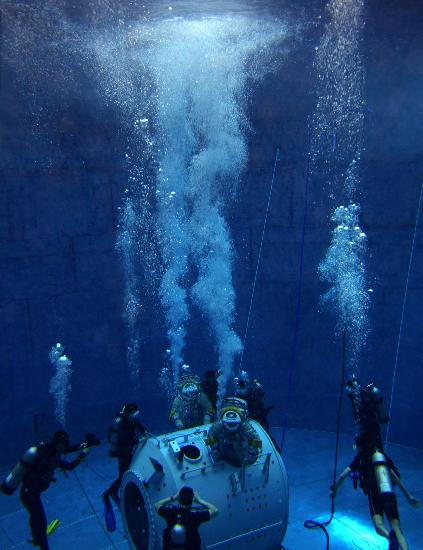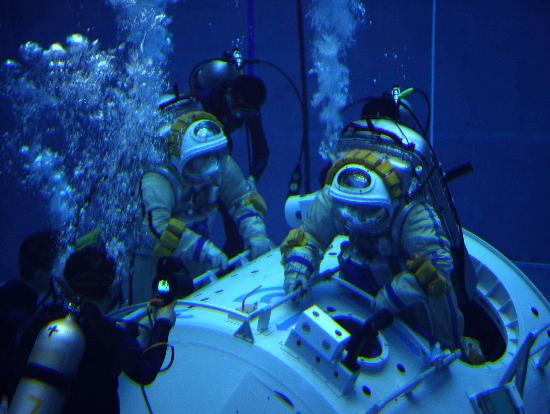Re: china manned space - news and views
Tracking, Telemetry & Command (TT&C) Network
Last updated: 4 April 2008
The PRC’s space tracking, telemetry and control (TT&C) network was built in the late 1960s and became operational in the early 1970s to support the country’s long-range ballistic missile and space programmes. The network provides tracking data for ballistic missile tests and space launches, as well as support for the operation, control, and maintenance of all PRC satellites in space. In addition, the network has limited capability of monitoring and identifying objects in space and providing early warning of a ballistic missile attack on the Chinese territory.
The TT&C network consists of an aerospace command & control centre in Beijing, a satellite control centre in Xi’an, several land-based space tracking stations located both inside the PRC and overseas, and five space tracking ships to provide a global coverage of TT&C capability. All TT&C facilities are manned by both military personnel from the PLA General Armament Department (GAD) and civilians working in the PRC space industry.
The initial TT&C network was based on VHF radio telemetry and tracking systems, which had a poor tracking accuracy and was easily disrupted by civilian radio and television broadcasting signals. The system has been retired since 2004~2005. A second network working at the C-band was built in the 1970s to support the geosynchronous orbit (GEO) launch missions. In the 1990s, a high-accuracy unified S-band (USB) that combines tracking and ranging, command, audio and video links into a single antenna was built to support the Project 921 manned spaceflight programme. This network included a new domestic tracking station and four overseas tracking stations.
The PRC is studying an indigenous Data Relay Satellite (DRS) System to supplement the existing TT&C network for future spaceflight missions. The system will include two geostationary satellites and relay data from 5-10 satellites at a time while covering 85% of the globe.
Domestic Tracking Stations
Weinan Station, military codename: Qinling or No.28 Computing Station, was built in the 1970s as a key missile and space tracking facility. It was intended to serve as the command and control centre for the PRC’s ballistic missile early warning system. The station is located in Weinan City, about 60km northeast of Xi’an City in Shaanxi Province. Because of its unique location, the station is able to track missiles and launch vehicles launched from all three PRC launch sites. In the Shenzhou manned space flight missions, Weinan Station is responsible for tracking and monitoring the launch vehicle and spacecraft during the ascent stage. According to the Chinese media report, by 2002 the station had supported “14 strategic ballistic missile tests and over 30 satellite launch missions”.
The Weinan Space Tracking station (Source: Chinese Internet)
Changchun Station, military codename: Changcheng (“Great Wall”), is the space tracking and missile early warning station located in Changchun City, Jilin Province.
Qingdao Station (also known as Bohai Station) was originally built in the 1970s for the missile tracking and early warning role. It was upgraded in the 1990s to support the Project 921 manned spaceflight programme. Located in Qingdao City, Shandong Province on China’s east coast, the station plays a key role in monitoring the launch vehicle during the ascend stage of the launch, and controlling the spacecraft to enter its scheduled orbit. In 2007, a new 18m-diametre tracking radar dish was installed in the station to receive data transmitted back from the Chang’e lunar orbiting probe.
The Qingdao Space Tracking station (Source: Chinese Internet)
Zhanyi (Guilin) Station is located in Zhanyi County, Guilin, Yunan Province in southern China. The station mainly supports GEO launches conducted from the Xichang Satellite Launch Centre (XSLC).
[imghttp://www.sinodefence.com/strategic/facilities/images/ttc_05.jpg[/img]
The 110 mono-pulse radar at the Zhanyi Space/Missile Tracking station (Source: Chinese Internet)
Nanhai Station is located near the Yulin Naval Base on the Hainan Island. It supports GEO launches conducted from XSLC.
Karshi Station, also known as Tianshan Station, is located in Shule County in Xinjiang. It is the westernmost tracking station within PRC’s territory and plays a key role during the re-entry of the Shenzhou spacecraft.
Xiamen Station, military codename: Qianshao (“Vanguard”), is a missile and space tracking facility located in Xiamen City, Fujian Province on the east coast.
Lushan Station, military codename: Huanghe (“Yellow River”) was built in the late 1970s.
Jiamusi Station is a space and missile tracking station located in Jiamusi City, Heilongjiang Province.
The radar of the Jiamusi Space/Missile Tracking station (Source: Chinese Internet)
Dongfeng Station is located in the Jiuquan Satellite Launch Centre (JSLC) in Inner Mongolia. The station provides tracking data during the take-off and re-entry of the Shenzhou spacecraft.
Hetian Station is a mobile station located in Xinjiang. It provides tracking data during the flight and re-entry of the Shenzhou capsule.
A mobile station is deployed in the landing site of the Shenzhou spacecraft in Siziwang Banner, Inner Mongolia. The station is responsible for locating the re-entry capsule during its landing.
http://maps.google.com/staticmap?center=35.8890,103.9746&zoom=3&size=512x400&maptype=roadmap&markers=34.4986,109.4993,greent|43.8860,125.3292,greent|36.0735,120.3655,greent|25.2782,110.2793,greent|18.2371,109.5254,greent|39.4616,75.9924,greent|24.4621,118.1085,greent|40.9653,100.2461,greent&key=ABQIAAAAoOISrxbr_TRWzffyZRSeCxQyjgJmuPcNAgrLzGG5v9lnXqEX4RSz7253y_-W6nxG1JtODirPGlWTUw
Domestic space tracking stations
Overseas Tracking Stations
Karachi Station was possibly built in the late 1990s to support the Project 921 manned space flight programme. The facility has been providing tracking data for Shenzhou flight missions since 1999.
Tarawa Station located on the South Tarawa Island, Republic of Kiribati was opened in 1997 to support the Project 921 manned space flight programme. However, the status of the facility became gloomy in November 2003 after the President Anote Tong’s decision to officially recognise Taiwan as an independent state. PRC has been reportedly looking for an alternative site for a new station in the region.
Malindi (Kenya) Station is located at Malindi, an Indian Ocean coastal town in the Republic of Kenya in Eastern Africa. The station became operational in July 2005 to support the . Shenzhou 6 manned space flight mission.
Swakopmund (Namibia) Station was completed in July 2001 following an agreement signed in October 2000 between the governments of the PRC and Namibia. Swakopmund is a South Atlantic costal down in central Namibia in Southern Africa. The station together with Yuanwang 3 space tracking ship stationed in South Atlantic provides crucial tracking and control during the re-entry of the Shenzhou spacecraft. According to Chinese media report, the facility is staffed by 16 engineers and technicians.
Additionally, the PRC has signed agreements with France, Brazil, Sweden and Australia to share space tracking facilities for mutual benefits.
Yuanwang Space Tracking Ships
The PRC currently deploys five Yuanwang space tracking ships to supplement the land-based tracking stations in its space programme. In a typical Shenzhou flight mission, Yuanwang 1 is positioned in the West Pacific off the Chinese coast; Yuanwang 2 is positioned about 1,500km southwest of French Polynesia in Southern Pacific; Yuanwang 3 is positioned off the Namibian coast in the Atlantic; Yuanwang 4 is positioned off the coast of Western Australian in the Indian Ocean. Yuanwang 1,2 and 3 are capable of tracking and controlling the spacecraft during its launch, flight and re-entry, as well as communications relay between the Beijing command centre and the spacecraft, while Yuanwang 4 is only capable of tracking the spacecraft. Two new ships (Yuanwang 5 and 6) have been commissioned recently. Please see main article: Yuanwang Space Tracking Ships.
Xi’an Satellite Control Centre (XSCC)
XSCC, also known as Base 26 in its military code name, is located in Xi’an City, Shaanxi Province. It is the nerve centre of the PRC’s TT&C network and the primary satellite (unmanned missions) control facility. All domestic and overseas ground tracking stations are subordinate to XSCC in administrative structure.
The Xi'an Satellite Control Centre (Source: Chinese Internet)
Beijing Aerospace Command & Control Centre (BACC)
Please see main article: Beijing Aerospace Command & Control Centre (BACC)
Operations
During a typical Shenzhou flight mission, three tracking stations are responsible for the tracking and monitoring of the launch vehicle and spacecraft in the ascent stage: Dongfeng (JSLC), Weinan and Qingdao.
Once the spacecraft is separated from the launch vehicle, it enters the initial orbit and deploy its solar panels under the command of the Qingdao Tracking Station and two space tracking ships: Yuanwang 1 positioned in the West Pacific off the Chinese coast and Yuanwang 2 positioned about 1,500km southwest of French Polynesia in the Southern Pacific.
During the retrofire stage, the tracking and controlling is carried out by Yuanwang 3 space tracking ship positioned off the South African coast in the Atlantic and the ground station located at Swakopmund, Namibia. Under the control of the two stations, the spacecraft changes its flight status, jettisons its orbital module, and start retrofire to slow down for re-entry.
The re-entry of the capsule is monitored and controlled by a range of tracking stations lined up in the Central Asia region, including the Karachi Tracking Station in Pakistan, two domestic tracking stations at Hetian (Xinjiang) and Karshi (Xijiang), the Dongfeng Tracking Station at JSLC, and the mobile tracking and control station at the landing site in Inner Mongolia.






